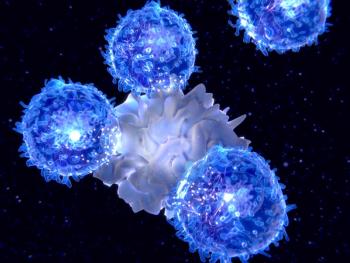
- ONCOLOGY Vol 26 No 1
- Volume 26
- Issue 1
Nodal Marginal Zone Lymphoma: What Do We Really Know?
Typically, when one authors a commentary piece, a good template to follow is to start with some background material, review the major findings of the paper in question, and then focus on areas of controversy and unanswered questions.
Typically, when one authors a commentary piece, a good template to follow is to start with some background material, review the major findings of the paper in question, and then focus on areas of controversy and unanswered questions. After reviewing the comprehensive article by Traverse-Glehen et al, we admittedly struggled to follow this template. Why is that? For starters, their review is so thorough, there is not much one can add. Additionally, while there are plenty of unanswered questions, there are few areas of controversy regarding the entity of nodal marginal zone lymphoma. Why so little controversy? Because there is relatively little research specific to this topic, it is hard for controversy to arise. The rarity of this diagnosis is responsible for the lack of large databases or clinical trial data on patients with this type of lymphoma. The authors are to be commended for compiling the several small series that do exist on this topic to create a relatively dense and high-quality overview of the clinical and diagnostic features of this tumor (including morphologic, immunophenotypic, cytogenetic, and molecular features). As the authors mention, there are limited data concerning prognostic markers and standards of care.
The advancement of knowledge and the establishment of standards of care are difficult for a wide variety of rare cancers. To address this topic, in December 2009, a workshop was held in Bethesda, Maryland, by the Cancer Biomarkers Research Group at the National Cancer Institute.[1] Approximately 200 participants, ranging from scientists and clinicians, to representatives of industry and government, to patient advocates, attended the workshop and discussed the issues that make studying rare cancers difficult. Breakout groups discussed the challenges involved in building a database, facilitating clinical studies, and developing new therapeutic strategies.
One concept proposed was the creation of Centers of Excellence for Rare Cancers. Such centers could “serve as coordinating centers for national and international efforts to collect biosamples, pool scientific expertise, train new investigators, link to advocacy groups, and share novel insights.” Additionally, clinicians at such centers would, by seeing a higher volume of patients with rare malignancies, be able to obtain the experience necessary to study and treat such tumors. Funding was identified as another barrier. In this era of limited resources, available dollars are often prioritized and awarded to research that will impact a greater number of patients. The workshop attendants proposed that the proposed Centers of Excellence and a robust investigator pool (specifically dedicated to the study of the rare cancer types) would aid in acquiring funding.
More clinical trials for entities such as nodal marginal zone lymphoma may not be a viable solution. Given the “overhead” that comes with each trial, it is simply not feasible for most centers to open trials for rare diseases. While this is a shame, we do not see this landscape changing anytime soon. One imperfect solution is to incorporate the rare entities into larger trials designed for a biologically similar disease. For example, the RESORT trial,[2] which addressed the question of maintenance rituximab vs retreatment rituximab, was designed statistically to test the question in patients with follicular lymphoma (a more common entity). In addition, patients with nodal marginal zone lymphoma and other less common indolent B-cell lymphoma subtypes were allowed on study, with a goal of generating some data in these less common entitities. The problem with this strategy, however, is that typically so few patients with the rare entity end up on the trial that no firm conclusions can be drawn and one is just left with a “signal” that needs to be followed up. A better solution may be the creation of international registries analogous to the International Bone Marrow Transplant Registry (IBMTR). While such registries and databases have inherent limitations, they may be the best way to move this field forward.
Traverse-Glehen et al have provided an excellent review summarizing what is known about nodal marginal zone lymphoma. Their review also provides us with an opportunity to reflect on how much we don’t know, and to think about how that knowledge gap can be addressed. We hope that with more collaborative international studies and registries we might be able to accelerate learning about this and the other rare entities that we encounter in cancer medicine.
Financial Disclosure:The authors have no significant financial interest or other relationship with the manufacturers of any products or providers of any service mentioned in this article.
References:
REFERENCES
1. Rare cancers: challenges for cancer prevention and treatment. Meeting sponsored by the Cancer Biomarkers Research Group of the National Cancer Institute. Bethesda, MD. December 2009. Executive summary available at:
2. Rituximab in treating patients with low tumor burden indolent non-Hodgkin's lymphoma. ClinicalTrials.gov identifier: NCT0075946. Available at:
Articles in this issue
almost 14 years ago
Improving Therapy for HER2-Positive Cancers Through Neoadjuvant Studiesalmost 14 years ago
Autonomy Versus Paternalism in Latin Americaalmost 14 years ago
Sequencing of Therapies in Advanced Prostate Canceralmost 14 years ago
What to Order From the Prostate Cancer Treatment Menu?almost 14 years ago
Nodal Marginal Zone Lymphoma: Impersonalized Medicinealmost 14 years ago
The Changing Scenario in Oncologist-Patient Communication: We Need to Adaptalmost 14 years ago
Nodal Marginal Zone B-Cell Lymphoma: A Diagnostic and Therapeutic DilemmaNewsletter
Stay up to date on recent advances in the multidisciplinary approach to cancer.

















































































